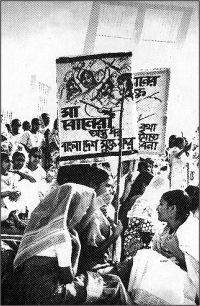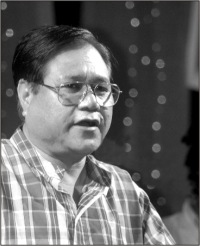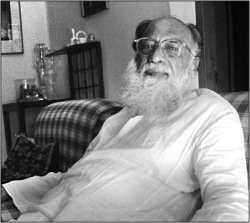Following
the path
of freedom
Fayza
Haq
 People
were working in TV on the subject of liberation
before the Liberation War,' says Mustafa
Manwar, recounting his experiences of the
liberation movement. 'There was the Jagorini
Gan. We had no means of special effects
and used a mirror or a camera to produce
the effect of 1,000 people. This went hand
in hand with songs like Songram, songram
cholbey. I was then the programme manager.
We had worked with Shukanto's poetry, Deshlai
and Runner, a small boy being included in
every procession in the city. We used to
be ready with the child in a car, and every
time we heard that there was a procession,
we went to it, with the boy. This portrayed
how this child was calling the people to
join the forces of liberation, the child
being the symbol of freedom. We could not
directly spell out that this was the call
for freedom. There was a sound of gunfire
but the child would pick himself up and
continue with his struggle. This proved
to be effective.
People
were working in TV on the subject of liberation
before the Liberation War,' says Mustafa
Manwar, recounting his experiences of the
liberation movement. 'There was the Jagorini
Gan. We had no means of special effects
and used a mirror or a camera to produce
the effect of 1,000 people. This went hand
in hand with songs like Songram, songram
cholbey. I was then the programme manager.
We had worked with Shukanto's poetry, Deshlai
and Runner, a small boy being included in
every procession in the city. We used to
be ready with the child in a car, and every
time we heard that there was a procession,
we went to it, with the boy. This portrayed
how this child was calling the people to
join the forces of liberation, the child
being the symbol of freedom. We could not
directly spell out that this was the call
for freedom. There was a sound of gunfire
but the child would pick himself up and
continue with his struggle. This proved
to be effective.
'There was then the recitation
of poems of rebellion taken from Tagore
and Nazrul, like Nai nai bhoey , Hobey hobey
joey, Sikander Abu Jaffer's Jonotar shangram
cholbey, and Ektara tui desher kotha bol.
These used to be illustrated and I did the
drawing and painting for this.'
On 23rd March, they realised
that there was no flying of the national
flag in the city of Dhaka, and they were
compelled to fly it on the TV. They had
a plan. Normally the TV then went on till
10pm. They decided to have patriotic songs
till the end. There were about 50 Pak soldiers
camped in the TV station and the major in
charge asked at 11pm why the programmes
were not finishing. Finally, there was only
a handful of TV workers, and Masuma Khatun
said that she would make the final announcement.
At two minutes past midnight, she announced
that it was the 24th March and that the
programmes had ended. Thus the TV authorities
had defied the regulation of flying the
flag on the national day. After that we
all went into hiding. This was followed
by the crackdown on the 25th.
'At Agartala, we did some
recordings of songs and went onward to Kolkata.
We formed a cultural team, that I headed,
and went to different parts of India. Waheedul
Haque looked after the musical section,'
Mustafa Manwar said. The artists who had
gathered there from Bangladesh presented
an exhibition, under the banner of the Liberation
War. Shug Dev did a documentary of the time
and included the works of the different
artists. Mustafa Manwar's own painting was
that of a mother holding a wounded and dying
freedom fighter on her lap. She was seen
sitting on a 'char'. Dev Dulal Bandy-opaddhaya
praised this effort. They held a large function
on TV in Delhi.
Visiting the camp of the
refugees from Bangladesh, Mustafa Manwar
found all the inmates often grim and depressed.
To change their mood he decided to introduce
puppets. Among the puppets were the characters
of Yahya Khan and an ordinary farmer. This
brought fun and frolic. 'After a long time
we laughed,' people said, and this gave
Mustafa Manwar a lot of satisfaction. A
visiting American documentary maker made
a film of these puppets. Later, Tarik Masud
added many shots to those taken by a foreign
film maker and called it Muktir Gaan. Artists
often made posters under the guidance of
Quamrul Hassan and took out processions
with them. Thus, cultural teams worked in
Kolkata and different parts of India in
praise of the liberation movement. Someone
from UK collected the paintings of Bangladeshi
artists and printed them overseas.
Mustafa Manwar came back
on December 18, 1971, being among the first
group of civilians to return to Bangladesh
from India by plane, and with the return
of Sheikh Mujibur Rahman, they presented
TV in a different way. Now the Bangl-adeshi
culture was no longer to be muffled. Meanwhile,
at this time, Shawkat Osman wrote a long
article on the Liberation War in the newspaper
Desh, and Mustafa Manwar did all its illustrations
in six issues. Renowned filmaker Satyajit
Ray, on seeing these drawings, was very
impressed.
Passion
for independence
Novera
Deepita
 The
station of Shwadhin Bangla Betar Kendra
(SBBK), situated at Ballygunge Road of Kolkata
came to be recognised soon as Mujibnagar.
Buoyed by the spirit of the Liberation War,
Rothin joined the radio and his voice was
his weapon for the war.
The
station of Shwadhin Bangla Betar Kendra
(SBBK), situated at Ballygunge Road of Kolkata
came to be recognised soon as Mujibnagar.
Buoyed by the spirit of the Liberation War,
Rothin joined the radio and his voice was
his weapon for the war.
SBBK started its journey
in May right after the formation of the
Mujibnagar Government in April 17, 1971.'My
songs O Biral rui machher matha khaiona,
Joy Bangla boila re, Amar neta tomar neta
were already being aired even before I joined
SBBK,' says a nostalgic Rothin.
In April eminent filmmaker
Subhash Dutta first told Rothin about SBBK.
However, it was not until June that Rothin
could join the radio. 'Although I passionately
wanted to join the Liberation War, I never
wanted to leave the country,' says Rothin.
However, the situation soon grew hostile,
'especially for the Bangalee minority.'
So, one night in mid-May,
Rothin and his family set out for the Indian
border. Rothin still remembers the horror
of that journey. 'About 500 rickshaws were
moving very slowly along the Dhaka-Chittagong
highway. What was most amazing was that
there was dead silence every where-- even
the children forgot to cry!
Rothin left his family safely
at Jalpaiguri and came to Kolkata by train
to locate the office of SBBK. 'I didn't
need a ticket on the train. The Indian trains
at that time were free for anyone who would
say "Joy Bangla",' fondly reminisces
Rothin.
However, Rothin's entry
to the SBBK office was not easy. 'I only
knew that it was in Ballygunge Road but
didn't know the exact location. When, I
finally found the Bangladeshi High Commission
at Balu Hakkak Lane,' Rothin says, 'the
guards would not let me in.' 'I was in deep
trouble since I had burnt all my papers
and documents to avoid identification. Somehow,
I was lucky enough to find my certificate
of being an enlisted artiste,' recalls Rothin.
The guard finally showed
Rothin the nearby office of Joy Bangla,
a newspaper brought out by Bangalees. Here
I met Shah Ali Sarkar, who is one of the
founding members of the SBBK He was overwhelmed
when he learnt my identity. The next morning
I met my friends Abdul Jabbar and Apel Mahmud.
There were other people from Bangladesh
Betar including Ashfaqur Rahman Khan, Motahar
TH Shikdar, Shahidul Islam and Kamal Lohani.
I was greeted warmly by all of them,' reminisces
Rothin.
On the very first night
of Rothin's arrival at SBBK, Apel Mahmud
said that he had tuned a song for him. Rothin's
first song with SBBK was Tir hara ei dheuer
shagar, written by Gobinda Haldar. 'In the
evening we recorded the song and it was
aired the next day. It became very popular
instantly,' recalls Rothin.
'The recording machine was
a very ordinary compared to the facilities
of today. Our only duty was to record the
programmes and keep the tapes in a safe
place. We were not told from where the songs
were transmitted,' says Rothin.
'After a few days, eminent
musicians Samar Das, Ajit Roy and Shujeo
Shyam came to SBBK. Their arrival added
a new dimension to the productions. For,
these artistes composed innumerable inspirational
songs with passion and patriotism,' comments
Rothin.
Rothin says, 'Songs like
Purba digantey shurjo uthechhe, Nongor tolo
tolo, Tara e desher shabuj dhaner, Swadhin
swadhin dikey dikey had been composed then.
Joy Bangla Banglar joy was the signature
tune of the station. It was actually a song
composed for a film. Gazi Mazharul Anwar
was the lyricist. Composers like Shahidul
Islam and TH Shikdar did many inspirational
songs. I have recorded more than 50 songs
during the Liberation War. Among my other
popular songs are Chashader muteder majurer,
O bhai khati shonar cheye, O bogilarey,
Poraner bandhu re, Amar desher shonar dhan,
O bhai mor bangalee re.'
The artistes of SBBK used
to go to the camps of freedom fighters in
the Muktanchal and in the refugee camps
to inspire them. Rothin vividly recalls
many emotional incidents of that time. A
team had come to recruit freedom fighters.
A boy who sought membership in the team
was adamant about going, against his mother's
will. The boy got into the truck while the
mother desperately ran after it and pleaded
with her son to have his last meal from
her. Can you tell me how I can forget that
moment?' says an overcome Rothindra Nath
Roy.
'Stop
Genocide'
Depicting
the actual
massacre
Afsar
Ahmed
 An
old lady is journeying towards an unknown
destination leaving everything behind--her
motherland, her home, her blood relations
and her dreams. The toils and travails,
the agonies depicted in her face are enough
to touch anyone's heart. This scene from
the documentary Stop Genocide is so moving
that anyone can feel the horror of the brutality
and genocide going on in the then East Pakistan.
Stop Genocide was the perfect depiction
of that time,' says a nostalgic MA Khayer,
who was the in-charge of the Film Division
of the Mujibnagar Government's Information
Ministry in 1971.
An
old lady is journeying towards an unknown
destination leaving everything behind--her
motherland, her home, her blood relations
and her dreams. The toils and travails,
the agonies depicted in her face are enough
to touch anyone's heart. This scene from
the documentary Stop Genocide is so moving
that anyone can feel the horror of the brutality
and genocide going on in the then East Pakistan.
Stop Genocide was the perfect depiction
of that time,' says a nostalgic MA Khayer,
who was the in-charge of the Film Division
of the Mujibnagar Government's Information
Ministry in 1971.
'The film was completely
Zahir Raihan's concept. He firmly believed
that a film projecting the true picture
of brutal human rights violation by the
then Pakistani government could create world
opinion against those acts more effectively
than meetings and processions. It was during
April-May 1971 when he came up with the
concept of making a film on the genocide,
but the Motion Picture Association of Bengal
didn't take it seriously at first. Finally,
however, Zahir Raihan convinced them and
the rest is history.'
Directed by Zahir Raihan
with the assistance of Alamgir Kabir, Stop
Genocide faced a lot of obstacles especially
regarding its finance, says Khayer. 'The
Motion Picture Association of Bengal helped
a lot for financing the film. Dr AR Mallick,
the Chairman of the Liberation Council of
Intelligentsia, also provided the financial
help for the film,' he informs.
Abul Khayer also came forward
to promote the film on behalf of the Mujibnagar
Government. 'But the path wasn't that easy.
The inside story was different. The then
Mujibnagar Government wished to produce
film on the Liberation War and its leadership
rather than the genocide. The principal
reason of their objection was a missing
link in the film: the absence of our great
leader Bangabandhu,' says Khayer. 'But,
Zahir Raihan wanted to earn recognition
of our war of independence. He firmly believed
that the whole war was by the name of Bangabandhu
and, at the same time he also believed that
the whole world knew it. Even, all the slogans
contained his name and the freedom fighters
used to take oath by his name. Raihan felt
that it wasn't necessary to highlight Bangabandhu
again and again and intentionally left out
his name from his film.
'But Zahir Raihan had a
completely neutral angle in this regard:
he was more willing to project the real
picture of the genocide than the political
affiliations of the war for creating more
effective opinion,' says Khayer. The brutality
of the genocide and the apathy and the struggle
of the migrated general people were the
main theme projected in this subtle documentary.
The language was simple and appealing. And
that's why, Stop Genocide acclaimed the
emblem of the true picture of that time,
as Khayer perceives.
'On its first screening
at a secret place in India, the cabinet
of Mujibnagar Government including Acting
President Syed Nazrul Islam, Prime Minister
Tajuddin Ahmed, AHM Kamruzzaman and the
politicians present there became totally
emotional. The film also helped us gain
the Indian support in the Liberation War,'
recalls Khayer.
'It was the middle of the
war and we were in Kolkata. The cabinet
of the Mujibnagar Government decided to
make another film on the Liberation War
by Zahir Raihan. Tajuddin Ahmed himself
asked me to tell Raihan about the project.
I contacted Raihan and he didn't refuse.
He made four films out of the budget sanctioned
for him! The films were Birth of a Nation,
Children of Bangladesh, Surrender and the
other one I can't recall now. The films
were very well-made but we are so unfortunate
that we couldn't be able to preserve these
films.
The films were sent from
India and Khayer is sure that the films
reached the soil of Bangladesh. But he cannot
tell how they have lost forever. 'We can't
preserve our heritage--our past achievements,
those glorious events and people behind
them,' regrets MA Khayer.

